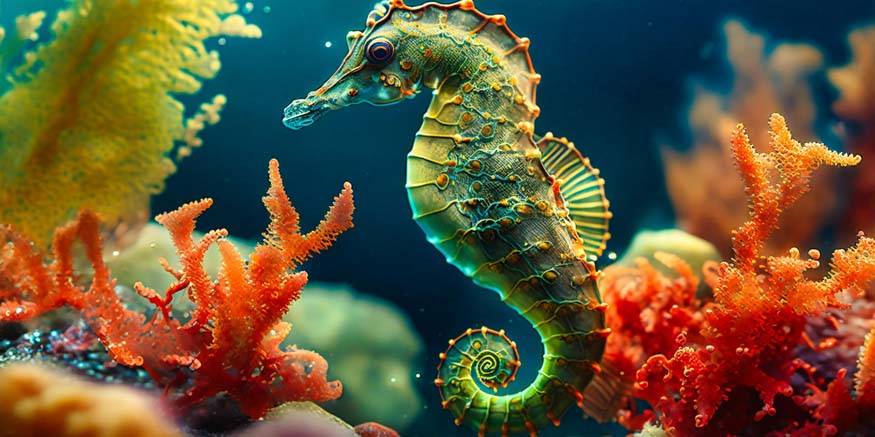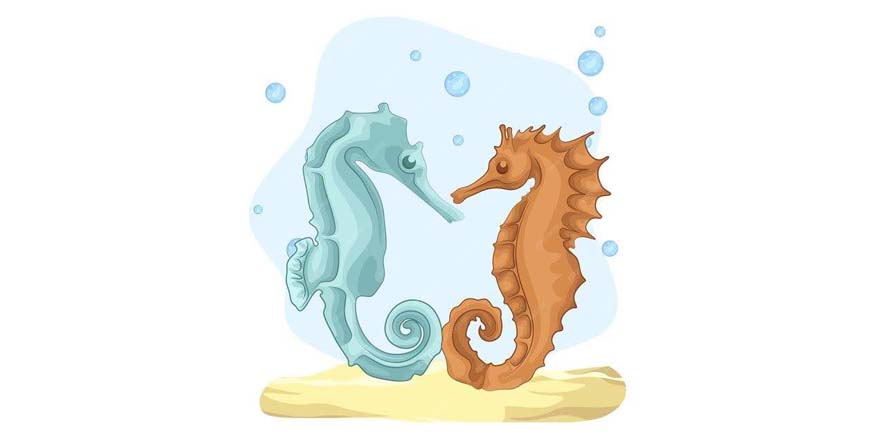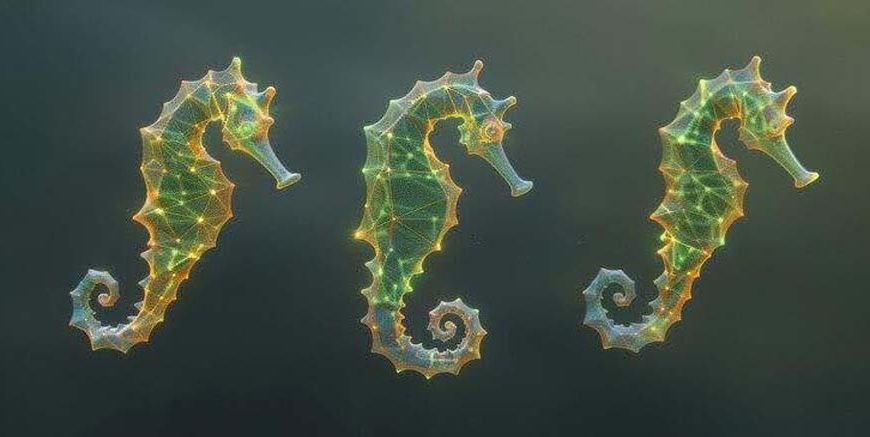Is it at all possible that you have encountered something in this world that you could almost swear is from a fairy tale? Well, guess what? Seahorses are right on the dot! It is worth noting that these intriguing creatures are so peculiar that they are bordering on the unexplainable realm of magic.
Table of Content:
- What is a Seahorse?
- Types of Seahorses
- Seahorse Facts for Kids
- Information about Seahorses
- Seahorses in Culture
- References
What is a Seahorse?
In particular if you had a fish which was the head of the horse, a monkey tail and kangaroo pouch. Seahorses have similar body structure to horses, this is the kind of animal we call seahorse. However, do not be deceived into thinking that seahorses are not fish when they indeed are fish, but not of any ordinary fish you have ever seen at local fish store’s tropical fish tank, ocean or other marine waters.

Seahorses got their name because Seahorses have heads similar to a small horse’s head. They possess elongated flexible necks and the lower part of the body, snout goes down to the ground like in the case of a horse. However, it has legs, but the truth is they actually have fins to enable them to swim. It is also important to note that while seahorses are fish, they swim in a rather unusual fashion – ‘seahorses swim upright position, which explains in simpler terms – they swim standing up’.
Types of Seahorses:
Seahorses for instance are not only one type of species, but a species that has to be numbered in the double digit, with a total of 14 sub species! According to world scientific acceptability and identification, there are 46 species of seahorses in the world. Let’s look at some of the most interesting ones:
- Dwarf Seahorse:
- Big-Belly Seahorse:
- Lined Seahorse:
- Pygmy Seahorse:
- Leafy Sea-Dragon:
There is a perception that this seahorse is one of the smallest known to inhabit the face of the earth. More are known as to how tiny they are that one could fit on your fingertip or perhaps on a needle. Dwarf seahorses are inhabiting zones in the Gulf of Mexico, and the Caribbean sea, and these are the tropical fish.
The female this seahorse is, of course, called big because it has a big and round belly.
This seahorse is named so in regards to the lines on its body bare. It can even change the colors like the grass and trees which is a very unique technique known as camouflage.
As seen from the image above, this seahorse is definitely a camouflage expert. Another unique species that is barely noticed because its size and the coral it lives on are almost indistinguishable is shaped and colored such that scientists did not even know of its existence until 1969.
Although it is not a seahorse which technically is a fish but it is related to it and it appears that it wears makeup made from leaves.
Seahorse Facts for Kids:

- Seahorses are Terrible Swimmers:
- Male Seahorses Give Birth:
- Seahorses Don’t Have Teeth or Stomachs:
- Seahorses are Monogamous:
- Seahorses Can Move Their Eyes Independently:
- Seahorses Wear a Crown:
- Seahorses are Masters of Camouflage:
- Seahorses Eat a Lot:
Surprisingly, seahorses that dwell in the sea possess very poor swimming abilities but can walk well. In fact, they can get exhausted just swimming in a current!
Interestingly, seahorses do not spew the sperm; instead, they gulp it down- this is probably the most astonishing feature about the seahorse species. A little bit of background about seahorses- it’s the male that gets pregnant and actually gives birth to the young. Female seahorse lays eggs into a pouch which is located on the ventral side of male’s abdomen and holds them until their hatching.
Staff-like structures resembling straws instead of teeth are located in the upper jaw of seahorses. Some species used them to pump food such as small sea creatures and anything that they could find they swallowed
This is a sure sign that they are loyal and will only have one man as their husband for the rest of their lives. They have some rituals that must be done- Each morning, both partners swim in circles and touch the tips of their tails.
One can be astonished to learn that these animals have something in common with chameleons and other homosexuals while focusing, namely, they are able to direct both of their eyes in different directions at the same time.
Some of the structures present in many kinds of seahorses are the coronet, a crown-like structure found on the head of the seahorse . This is an incredible fact- each seahorse’s coronet is absolutely different from
Some lizard varieties have a unique ability to adapt the color of their skin to that of the environment. And some species can form little skin ‘blades’ of it to camouflage with seaweed or coral.”
In fact, these little fellows have a great hunger! Seahorses are capable of eating as many as 3,000 pods of tiny shrimps per day.
Information about Seahorses:
- Habitat and Distribution:
- Diet:
- Reproduction:
- Conservation:
- Interesting Adaptations:
Seahorses inhabit warm and cold seas at the coastal regions of continents and islands of the world. And they are most favored to live in more or less quiet zones such as meadows of sea grasses, coral gardens and mangrove swamps.
Seahorses are members of the order Carnivora, so they feed on other animals, both large and small. They feed on minute sea living organisms such as krills (shrimp-sized organisms), fish minnows, and planktons. They actively employ their narrow snouts that look like vacuum cleaners to draw in their food substances.
One of the most unusual methods of reproduction in the test of the animal kingdom is the seahorses. It is interesting to note that female seahorses lay their eggs in the male partner’s pouch, which is called a brood pouch. The male copulates with the female and fertilizes her eggs, and she incubates them for between 2-4 weeks, depending on the species. When the process is complete, the male experiences contractions and is overtaken by fully-formed but dwarf seahorses. Interestingly, a seahorse can lay thousands of eggs at a time but it can lay as many as several hundred babies at once.
However, there is bad news because many of the seahorse species are endangered at the moment. Food crops are pollution and climate change affecting their natural environments. They have also been harvested for medicine and for being sold for aquarium fish and other pet trades.
Seahorses have some cool adaptations that help them survive:
- Instead of having tough skin like many other reptiles, their body is covered by bony plates- shields them from predators.
- They have a prehensile tail or a tail that looks like a hand which is useful in holding on to trees as well as objects when in water with strong currents.
- Large and sensitive eyes are possessed by Clever Critters that also have a mobility in the eyes to enable it to have clear vision of both prey and other animals.
Seahorses in Culture:

The seahorses constitute one of the most intriguing animals to have captured the interest of humans for many years now. They exist in the framework of mythical small Greek and Romans and in many cultures people associate them with bulky and force. Seahorses are still present in world of fantasy and can be found in books, movies, and artwork. Seahorses are, indeed, creatures to behold. All the way from the moment they look like horses on their heads to their curly tails, from males which are capable of giving birth right up to their wonderful capability of changing colors, seahorses are incredible.
The next time you come across information or watch a TV show or a movie of an aquarium or the life of aquatic creatures, try looking for seahorses. I think all of these tiny, fairy-tale-like beings are capable of revealing a great deal about the beauty of life beneath the ocean’s surface!
For more such interesting blogs, Visit EuroKids














